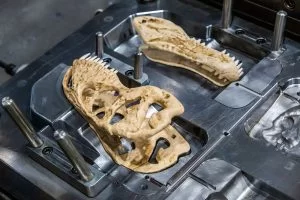If there is one important process in the plastics industry, because of all its applications, it is injection blow moulding. IBM (Injection Blow Moulding) is a two-step manufacturing process and is used to produce hollow parts such as bottles, containers, tanks and other containers.
The main feature of this method is that it combines plastic injection moulding with blow moulding to create products with complex shapes, thin walls and high-precision bottle necks.
In the following, we will learn how IBM is performed, as well as its main advantages and most common applications.

Injection moulding process
The first step in this type of moulding is the injection of molten thermoplastic into a mould to create a preform. The machine injects the molten plastic at high pressure into the mould cavity, which contains a hollow core or stem. The plastic cools and solidifies into the shape of the preform, which has a thick wall at the bottom with a hollow opening for the stem.
Two of the most common thermoplastics used in this process are polyethylene terephthalate (PET) and polypropylene (PP). PET is a rigid and tough material used for beverage bottles such as water and soft drinks. PP, on the other hand, is more flexible and lighter, and is therefore used for food packaging such as yoghurt or sauces.
Preforms usually have the bottle neck and thread already formed for greater precision. This makes it possible to automate the next blowing step, as the preform fits perfectly into the blow mould.
The preform is then removed from the injection mould, but remains on the mandrel for the next step of the process: blowing.
Blowing process
The preform is transferred to the blowing station and heated to soften the plastic, using infrared radiators. It is then placed into a hollow mould for the final part shape. The shank is extended so that the preform touches the bottom of the mould.
Compressed air is injected through the stem, which forces the hot plastic to expand and take the shape of the mould cavity. The air also cools the plastic.
After cooling and solidifying, the mould is opened and the finished part is removed for final finishing and inspection.
An advantage of IBM is that it allows greater control over wall thickness than extrusion blow moulding. It also produces parts with fewer defects and no visible seams. The biaxial orientation of the plastic during expansion improves strength and optical clarity
Materials and applications
In addition to polypropylene and PET, other commonly used thermoplastics include PE, PVC and ABS.
The injection blow moulding process is ideal for producing plastic packaging such as beverage bottles, cosmetic bottles, water and chemical bottles, and more. This is because the parts have thin walls, allow complex shapes, are high strength and low weight.
One of its applications is in the pharmaceutical industry. IBM-produced medicine bottles are robust and precise, ensuring they are safe to contain drugs without tampering, while featuring a perfect fit with child-resistant closure mechanisms.
Water bottles and sports drinks are another good example where uniformity and strength are essential. These bottles are produced with a uniform thickness, which makes them resistant to deformation under pressure, such as when squeezed by an athlete while drinking.
In the cosmetics industry, containers must have an attractive, attention-grabbing aesthetic. IBM enables the creation of packaging with complex shapes and smooth surfaces that are ideal for decorative printing, labelling and high quality branding, contributing to product shelf appeal.
Toy manufacturers use this process to produce hollow parts. Toys benefit from the strength and safety it offers.
In the automotive industry, it is used to make parts, such as fluid reservoirs or air ducts, strong enough to withstand the extreme conditions under the bonnet of a vehicle.
Advantages of IBM (H2)
We have already seen several advantages of injection and blow moulding, but at this point, let’s recall some of them and mention some new ones:
- Allows complex shapes with precise bottlenecks.
- Produces parts with uniform wall thickness.
- Improves the optical and barrier properties of the plastic.
- Enables hollow plastic parts to be created in large quantities.
- Low production cost compared to other moulding processes.
* It does not require welds at the joints, so it has fewer defects.
With this, we can conclude that injection blow moulding is a versatile and quite cost-effective process, which can be used to produce a wide variety of lightweight and strong plastic containers. The combination of injection blow moulding and blow moulding allows a high level of control over the shape, wall thickness, transparency and barrier properties of the finished parts.





 by
by